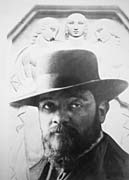
Pedro Zonza Briano was born on November 27, 1866, in a humble home in La Boca. He studies at the Sociedad Estímulo de Bellas Artes with Lucio Correa Morales. Before turning twenty, he presents Dolor (Pain) –a naked child lying down– in a collective exhibition. His work causes surprise and José León Pagano qualifies it as “...a sense of form rarely found”. In 1908 he gets the Premio Roma and parts to Europe. He first resides in Italy and later in Paris. In 1911 he takes part in the Exposición Mundial de Roma (World Exhibition in Rome) with a group of three nude male figures of natural size titled El pensamiento helénico (The Hellenic thought), of which the art critic Atalaya in Buenos Aires comments:
“[...] domineering, the trilogy of Zonza Briano stands out [...] in this entire group, whose forms are related to the perfect unity of thought, where art generously overflows. This is the culmination, not only of his artistic life in Argentina, but of the entire world [...] he surely possess the form, which he is willing to sacrifice to give way to the idea [...] in order to maintain the vigor and plenty fullness of his conception [...] Those who have not understood his conception are some critics [...]”
He exhibits in Brussels and Venice sculptures that were developed during his stay in Europe: El origen de las pasiones (The origins of passion) (1909) and Así habló Zaratustra (Such spoke Zaratustra) (1910). He takes part in the Exposición Internacional del Centenario (1910) and those held in San Francisco, California in 1910 and 1915, obtaining the Second and First Prize respectively. His successful career continues well into 1911 in London and Berlin, cities that acclaim the artistic passion of this young sculptor. That same year he returns to Buenos Aires, and in 1912, he exhibits at the Salón de París his work Creced y multiplicaos (Grow and multiply), which is accepted by the judges but is later taken away due to a legal order. His case takes public notice and he becomes known as “the genius” before what appears to be a disapproving general attitude. The following year, he presents this controversial piece at the Salón del Retiro and receives a major reward, as it was acquired by Museo Nacional de Bellas Artes. As of 1911, it is displayed at the Salón Nacional, and in 1913, it gets the Adquisición Prize.
In 1914, the critic Julio Rinaldini writes an adverse commentary about his Redentor, which speaks not only about his work, but also about his play on lights: “[...] what is the relationship with real art and this new display more related to show business? Does he mean that perhaps [...] his work is like strokes of light in the middle of the darkness? [...] This figure needs more vigor and a more ample expression in the eyes, more expression in the gestures. It looks like a sleepwalker [...] it reminds me of one of the bourgeoisie characters of Rodin’s Calais [...] the head of the Redentor (Redeemer) lacks beauty [...]”. He then adds as a footnote: “[...] the Redentor acquired by the Municipalidad (City Hall) is at present in Recoleta. There it has no iris flowers, nor incense nor lighting ad hoc. There you can better see that his work is an imitation [...] of this modern redemptory piece [...] no body no longer believes in his words [...]” A clear conflict between tradition and modern manifestations, or perhaps, as Atalaya would claim, lack of understanding about concept.
In 1924, he makes an individual exhibit at Amigos del Arte. In Buenos Aires we can see the Monumento a Leandro N. Alem (Maipú and L. N. Alem); Lucio Correa Morales and Flor de juventud (Parque Tres de Febrero) and Redentor (Cementerio de la Recoleta). His work also forms part of the Museo “Eduardo Sívori”, Museo “Quinquela Martín” de La Boca and of Instituto Histórico de la Ciudad de Buenos Aires.
He dies in Buenos Aires, on February 6, 1941.